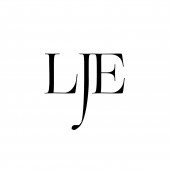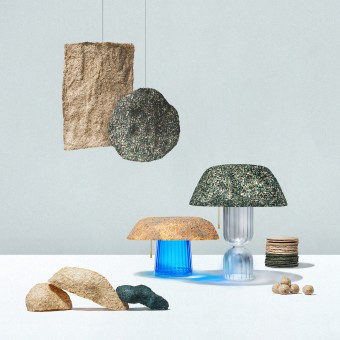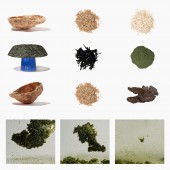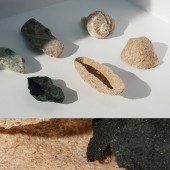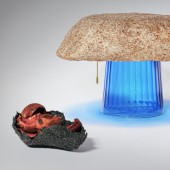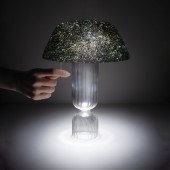DESIGN NAME:
Bonyeon
PRIMARY FUNCTION:
Biodegradable Material
INSPIRATION:
Large corporations produce biodegradable plastic, but this requires huge capital for production facilities and certain conditions for decomposition. So Jooen Lee developed a Bonyeon that could be easily made with a small capital, from material production to product making in a small workshop or at home, and easily thrown away in nature. This fresh idea is paired with a wider view that the agricultural and fishery byproducts thrown away every year can be a resource for new materials.
UNIQUE PROPERTIES / PROJECT DESCRIPTION:
Consisting only of discarded byproducts and microbial binders, this simple material is not only easy for individuals to produce, but also closely imitates the color and texture of nature and is rich in the natural aroma of byproducts. Bonyeon is light and durable, and the minerals and plant substances it contains promote air quality and regulate humidity so it is suitable for a wide range of living products, lighting or wall tiles, and it is decomposed by 100pct in a common natural environment.
OPERATION / FLOW / INTERACTION:
Biodegradable material Bonyeon that provides stability and vitality to users with dynamic texture and comfortable scent interacts with users, rural economy, and nature. Users can throw it onto the home yards, sea and soil like a banana peel and no harmful substances remain in the decomposition process. At the same time, Bonyeon is made from discarded byproducts, it creates additional income for farming and fishing villages, revitalizing the rural economy and alleviating local income inequality.
PROJECT DURATION AND LOCATION:
Bonyeon is an ongoing project. The prototype was designed in 2019 and is based in regions of Korea in Geochang, Wando and Nonsan. Jooen Lee has been working on manufacturing solutions to enhance the sustainability of materials and create solutions for a wide range of customers. With further improvements in transportation are expected to be completely co2 neutral by 2022. Jooen Lee plans to establish rural hub cooperatives to increase production while continuing to supply the domestic market.
|
PRODUCTION / REALIZATION TECHNOLOGY:
The lights and trays produced in the co2 neutral material cycle are made by layering thin layers of adhesives consisting of proteins and microorganisms and Korea's primary industry byproducts such as rice bran, bark and seaweed. This delicate mixture embodies a fragrance and color that does not lose its natural properties, and a unique surface texture is added to complete the vitality of nature. It can also be easily modeled by controlling its strength and elasticity with natural adhesives.
SPECIFICATIONS / TECHNICAL PROPERTIES:
Bonyeon is three versions of rice bran and sawdust, seaweed and mugwort, and rice bran and bark variants. As a prototype, lights and trays were developed.
The presented lighting object size: W190 mm x D190 mm x H220 mm, W 190mm x D 190mm x H 125mm
The presented tray object size: W60 mm x D160 mm x H60 mm, W93 mm x D106 mm x H50 mm, W70 mm x D110 mm x H26 mm
TAGS:
greendesign, biodegradation, eco, noplastic, interior, tray, plate, living, sustainable, homeware
RESEARCH ABSTRACT:
The idea of using only byproducts and microbes emerged as the embodiment of sustainable products, expressed in a new form by realizing the principle of circular sustainability. Bonyeon combines a unique construction method and nature-oriented design to create a delicate and unusual object. This is the result of years of research and experimentation for individuals to use wasted resources with little capital. Bonyeon artistically creates a meaningful symbiosis between users and local community.
CHALLENGE:
The hardest part of the project was finding a solution to produce new materials using innovative structural technologies that rely solely on the physical properties of powders and pallets of byproducts. Various experiments were conducted to create an overall harmonious impression by emulating the colors, fragrances and textures of nature. An additional challenge was to maintain that design, environment and farming and fishing villages can coexist and communicate with each other.
ADDED DATE:
2021-02-26 11:21:23
TEAM MEMBERS (1) :
IMAGE CREDITS:
#1~5 Photographer, Hyunggyu Kim, 2021.
|
